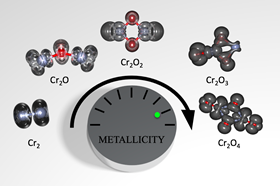 Chromium oxide clusters, composed of chromium and oxygen atoms, are prized for their unique electrical properties, which allow their conductance to be fine-tuned. The addition of oxygen atoms to chromium clusters increases their metallic properties. Image: Scott Sayres.
Chromium oxide clusters, composed of chromium and oxygen atoms, are prized for their unique electrical properties, which allow their conductance to be fine-tuned. The addition of oxygen atoms to chromium clusters increases their metallic properties. Image: Scott Sayres.If you’re old enough, you may still have a box of cassettes or VHS tapes lying around. These storage devices were popular in the 1970s and 80s, but have since fallen into disuse, replaced by CDs and other digital media. Now, researchers are taking a new look at chromium oxides, the magnetic chemical compounds once used to coat the surfaces of such tapes.
In a paper in the Journal of the American Chemical Society, Scott Sayres and Jacob Garcia, researchers in the Biodesign Center for Applied Structural Discovery and the School of Molecular Sciences at Arizona State University, report using mass spectroscopy and ultrafast laser pulses to interrogate chromium oxides in unprecedented detail.
“Chromium oxides are known to have really exciting magnetic and electronic properties,” says Sayres. “They're a very unique material that's poorly understood at the molecular level.”
Known as a half-metal, chromium oxide is an inorganic compound composed of oxygen and chromium atoms, which combine to form a crystal structure. The term half-metal alludes to the fact that chromium oxide's electrical properties can morph between high-conductance metallic behavior and low-conductance insulating behavior, depending on its electron configuration.
Using their interrogation approach, Sayres and Garcia were able to describe the behavior of clusters of chromium oxide atoms. These clusters can be fine-tuned to alter their electrical conductance, variously behaving as wire-like conductors of electricity, semiconductors or insulators, depending on the number of oxygen atoms present. One of the surprising findings of this study is that adding oxygen atoms to chromium compounds increases their metallic properties, and that these alterations can be very precisely controlled.
These findings open the door to a new breed of electronics that may soon reach the smallest possible scale, permitting the design of tunable, molecular-sized components that could vastly increase processing and storage capacities in new devices.
Such innovations are part of an ongoing change in electronics known as spintronics. While conventional electronic devices control the flow of electrical charge, spintronics also takes advantage of spin, a quantum property of electrons, potentially leading to greater storage capacity and faster data transfer.
The basic idea first found its way into consumer products in the late 1990s in the form of magnetic computer hard drives boasting several hundred times more storage capacity than their predecessors. Chromium oxides are particularly well suited for such applications due to their high spin polarity, a measure of the range of conductance states the chromium clusters can assume, based on the number of oxygen atoms (or oxidation state).
In the current study, Sayres and Garcia used a femtosecond laser as a camera to observe the motion of excited state electrons, capturing dynamic events that take place on a femtosecond time scale. As oxygen atoms were added to the chromium clusters, they were able to observe the subtle transitions between insulating and metallic conducting properties.
“We've tried to take the smallest possible building blocks of chromium oxide and change them atom by atom,” Sayres says. The results show that the bulk properties of chromium oxide persist down to an extremely small scale. “This means that we can make new devices out of very small amounts of material and still have these exciting electronic properties that chromium oxides are known for.”
In addition to a new generation of familiar electronic devices, chromium oxide-based spintronics may help pave the way for quantum computing.
This story is adapted from material from Arizona State University, with editorial changes made by Materials Today. The views expressed in this article do not necessarily represent those of Elsevier. Link to original source.